[English] 日本語
 Yorodumi
Yorodumi- PDB-7cz5: Cryo-EM structure of the human growth hormone-releasing hormone r... -
+ Open data
Open data
- Basic information
Basic information
| Entry | Database: PDB / ID: 7cz5 | ||||||
|---|---|---|---|---|---|---|---|
| Title | Cryo-EM structure of the human growth hormone-releasing hormone receptor-Gs protein complex | ||||||
 Components Components |
| ||||||
 Keywords Keywords | MEMBRANE PROTEIN / cognate receptor / Class B G-protein-coupled receptors / single particle | ||||||
| Function / homology |  Function and homology information Function and homology informationregulation of intracellular steroid hormone receptor signaling pathway / somatotropin secreting cell development / growth hormone-releasing hormone receptor binding / positive regulation of circadian sleep/wake cycle, REM sleep / growth hormone-releasing hormone receptor activity / growth hormone-releasing hormone activity / growth hormone secretion / adenohypophysis development / positive regulation of growth hormone secretion / regulation of protein metabolic process ...regulation of intracellular steroid hormone receptor signaling pathway / somatotropin secreting cell development / growth hormone-releasing hormone receptor binding / positive regulation of circadian sleep/wake cycle, REM sleep / growth hormone-releasing hormone receptor activity / growth hormone-releasing hormone activity / growth hormone secretion / adenohypophysis development / positive regulation of growth hormone secretion / regulation of protein metabolic process / positive regulation of multicellular organism growth / multicellular organismal reproductive process / neuropeptide hormone activity / G-protein activation / Activation of the phototransduction cascade / Glucagon-type ligand receptors / Thromboxane signalling through TP receptor / Sensory perception of sweet, bitter, and umami (glutamate) taste / G beta:gamma signalling through PI3Kgamma / G beta:gamma signalling through CDC42 / Cooperation of PDCL (PhLP1) and TRiC/CCT in G-protein beta folding / Activation of G protein gated Potassium channels / Inhibition of voltage gated Ca2+ channels via Gbeta/gamma subunits / Ca2+ pathway / G protein-coupled peptide receptor activity / G alpha (z) signalling events / Vasopressin regulates renal water homeostasis via Aquaporins / Glucagon-like Peptide-1 (GLP1) regulates insulin secretion / hormone metabolic process / nuclear outer membrane / Adrenaline,noradrenaline inhibits insulin secretion / ADP signalling through P2Y purinoceptor 12 / G alpha (q) signalling events / G alpha (i) signalling events / Thrombin signalling through proteinase activated receptors (PARs) / Activation of G protein gated Potassium channels / G-protein activation / G beta:gamma signalling through PI3Kgamma / Prostacyclin signalling through prostacyclin receptor / G beta:gamma signalling through PLC beta / ADP signalling through P2Y purinoceptor 1 / Thromboxane signalling through TP receptor / Presynaptic function of Kainate receptors / G beta:gamma signalling through CDC42 / Inhibition of voltage gated Ca2+ channels via Gbeta/gamma subunits / Glucagon-type ligand receptors / Adrenaline,noradrenaline inhibits insulin secretion / G alpha (12/13) signalling events / G beta:gamma signalling through BTK / alkylglycerophosphoethanolamine phosphodiesterase activity / ADP signalling through P2Y purinoceptor 12 / Cooperation of PDCL (PhLP1) and TRiC/CCT in G-protein beta folding / positive regulation of insulin-like growth factor receptor signaling pathway / Thrombin signalling through proteinase activated receptors (PARs) / Ca2+ pathway / nuclear inner membrane / G alpha (z) signalling events / Extra-nuclear estrogen signaling / G alpha (s) signalling events / response to food / G alpha (q) signalling events / peptide hormone receptor binding / photoreceptor outer segment membrane / G alpha (i) signalling events / Glucagon-like Peptide-1 (GLP1) regulates insulin secretion / spectrin binding / Vasopressin regulates renal water homeostasis via Aquaporins / growth factor binding / peptide hormone binding / PKA activation in glucagon signalling / hair follicle placode formation / mu-type opioid receptor binding / photoreceptor outer segment / developmental growth / corticotropin-releasing hormone receptor 1 binding / intracellular transport / D1 dopamine receptor binding / Hedgehog 'off' state / beta-2 adrenergic receptor binding / adenylate cyclase-activating adrenergic receptor signaling pathway / response to glucocorticoid / cell maturation / cardiac muscle cell apoptotic process / activation of adenylate cyclase activity / adenylate cyclase activator activity / lactation / photoreceptor inner segment / trans-Golgi network membrane / secretory granule / establishment of localization in cell / G protein-coupled receptor activity / determination of adult lifespan / ionotropic glutamate receptor binding / insulin-like growth factor receptor binding / G-protein beta/gamma-subunit complex binding / bone development / response to insulin / multicellular organism growth / adenylate cyclase-activating G protein-coupled receptor signaling pathway / terminal bouton Similarity search - Function | ||||||
| Biological species |  Homo sapiens (human) Homo sapiens (human)  synthetic construct (others) | ||||||
| Method | ELECTRON MICROSCOPY / single particle reconstruction / cryo EM / Resolution: 2.6 Å | ||||||
 Authors Authors | Zhou, F. / Zhang, H. / Cong, Z. / Zhao, L. / Zhou, Q. / Mao, C. / Cheng, X. / Shen, D. / Cai, X. / Ma, C. ...Zhou, F. / Zhang, H. / Cong, Z. / Zhao, L. / Zhou, Q. / Mao, C. / Cheng, X. / Shen, D. / Cai, X. / Ma, C. / Wang, Y. / Dai, A. / Zhou, Y. / Sun, W. / Zhao, F. / Zhao, S. / Jiang, H. / Jiang, Y. / Yang, D. / Xu, H.E. / Zhang, Y. / Wang, M. | ||||||
 Citation Citation |  Journal: Nat Commun / Year: 2020 Journal: Nat Commun / Year: 2020Title: Structural basis for activation of the growth hormone-releasing hormone receptor. Authors: Fulai Zhou / Huibing Zhang / Zhaotong Cong / Li-Hua Zhao / Qingtong Zhou / Chunyou Mao / Xi Cheng / Dan-Dan Shen / Xiaoqing Cai / Cheng Ma / Yuzhe Wang / Antao Dai / Yan Zhou / Wen Sun / ...Authors: Fulai Zhou / Huibing Zhang / Zhaotong Cong / Li-Hua Zhao / Qingtong Zhou / Chunyou Mao / Xi Cheng / Dan-Dan Shen / Xiaoqing Cai / Cheng Ma / Yuzhe Wang / Antao Dai / Yan Zhou / Wen Sun / Fenghui Zhao / Suwen Zhao / Hualiang Jiang / Yi Jiang / Dehua Yang / H Eric Xu / Yan Zhang / Ming-Wei Wang /  Abstract: Growth hormone-releasing hormone (GHRH) regulates the secretion of growth hormone that virtually controls metabolism and growth of every tissue through its binding to the cognate receptor (GHRHR). ...Growth hormone-releasing hormone (GHRH) regulates the secretion of growth hormone that virtually controls metabolism and growth of every tissue through its binding to the cognate receptor (GHRHR). Malfunction in GHRHR signaling is associated with abnormal growth, making GHRHR an attractive therapeutic target against dwarfism (e.g., isolated growth hormone deficiency, IGHD), gigantism, lipodystrophy and certain cancers. Here, we report the cryo-electron microscopy (cryo-EM) structure of the human GHRHR bound to its endogenous ligand and the stimulatory G protein at 2.6 Å. This high-resolution structure reveals a characteristic hormone recognition pattern of GHRH by GHRHR, where the α-helical GHRH forms an extensive and continuous network of interactions involving all the extracellular loops (ECLs), all the transmembrane (TM) helices except TM4, and the extracellular domain (ECD) of GHRHR, especially the N-terminus of GHRH that engages a broad set of specific interactions with the receptor. Mutagenesis and molecular dynamics (MD) simulations uncover detailed mechanisms by which IGHD-causing mutations lead to the impairment of GHRHR function. Our findings provide insights into the molecular basis of peptide recognition and receptor activation, thereby facilitating the development of structure-based drug discovery and precision medicine. | ||||||
| History |
|
- Structure visualization
Structure visualization
| Movie |
 Movie viewer Movie viewer |
|---|---|
| Structure viewer | Molecule:  Molmil Molmil Jmol/JSmol Jmol/JSmol |
- Downloads & links
Downloads & links
- Download
Download
| PDBx/mmCIF format |  7cz5.cif.gz 7cz5.cif.gz | 204.9 KB | Display |  PDBx/mmCIF format PDBx/mmCIF format |
|---|---|---|---|---|
| PDB format |  pdb7cz5.ent.gz pdb7cz5.ent.gz | 160.5 KB | Display |  PDB format PDB format |
| PDBx/mmJSON format |  7cz5.json.gz 7cz5.json.gz | Tree view |  PDBx/mmJSON format PDBx/mmJSON format | |
| Others |  Other downloads Other downloads |
-Validation report
| Summary document |  7cz5_validation.pdf.gz 7cz5_validation.pdf.gz | 975.8 KB | Display |  wwPDB validaton report wwPDB validaton report |
|---|---|---|---|---|
| Full document |  7cz5_full_validation.pdf.gz 7cz5_full_validation.pdf.gz | 996.3 KB | Display | |
| Data in XML |  7cz5_validation.xml.gz 7cz5_validation.xml.gz | 33.8 KB | Display | |
| Data in CIF |  7cz5_validation.cif.gz 7cz5_validation.cif.gz | 50.7 KB | Display | |
| Arichive directory |  https://data.pdbj.org/pub/pdb/validation_reports/cz/7cz5 https://data.pdbj.org/pub/pdb/validation_reports/cz/7cz5 ftp://data.pdbj.org/pub/pdb/validation_reports/cz/7cz5 ftp://data.pdbj.org/pub/pdb/validation_reports/cz/7cz5 | HTTPS FTP |
-Related structure data
| Related structure data |  30505MC M: map data used to model this data C: citing same article ( |
|---|---|
| Similar structure data |
- Links
Links
- Assembly
Assembly
| Deposited unit | 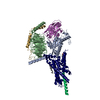
|
|---|---|
| 1 |
|
- Components
Components
-Protein , 2 types, 2 molecules RN
| #1: Protein | Mass: 61651.438 Da / Num. of mol.: 1 Source method: isolated from a genetically manipulated source Source: (gene. exp.)  Homo sapiens (human) / Gene: GHRHR / Production host: Homo sapiens (human) / Gene: GHRHR / Production host:  |
|---|---|
| #6: Protein | Mass: 13711.284 Da / Num. of mol.: 1 Source method: isolated from a genetically manipulated source Source: (gene. exp.) synthetic construct (others) / Production host:  |
-Guanine nucleotide-binding protein ... , 3 types, 3 molecules ABG
| #2: Protein | Mass: 45683.434 Da / Num. of mol.: 1 Mutation: S54N, G226A, E268A, N271K, K274D, R280K, T284D, I285T Source method: isolated from a genetically manipulated source Source: (gene. exp.)  Homo sapiens (human) / Gene: GNAS, GNAS1, GSP / Production host: Homo sapiens (human) / Gene: GNAS, GNAS1, GSP / Production host:  |
|---|---|
| #4: Protein | Mass: 43706.750 Da / Num. of mol.: 1 Source method: isolated from a genetically manipulated source Source: (gene. exp.)   |
| #5: Protein | Mass: 7861.143 Da / Num. of mol.: 1 Source method: isolated from a genetically manipulated source Source: (gene. exp.)   |
-Protein/peptide , 1 types, 1 molecules P
| #3: Protein/peptide | Mass: 5048.702 Da / Num. of mol.: 1 / Source method: obtained synthetically / Source: (synth.)  Homo sapiens (human) / References: UniProt: P01286 Homo sapiens (human) / References: UniProt: P01286 |
|---|
-Non-polymers , 3 types, 6 molecules 




| #7: Chemical | | #8: Chemical | ChemComp-CLR / | #9: Water | ChemComp-HOH / | |
|---|
-Details
| Has ligand of interest | N |
|---|
-Experimental details
-Experiment
| Experiment | Method: ELECTRON MICROSCOPY |
|---|---|
| EM experiment | Aggregation state: PARTICLE / 3D reconstruction method: single particle reconstruction |
- Sample preparation
Sample preparation
| Component |
| |||||||||||||||||||||||||||||||||||||||||||||||||
|---|---|---|---|---|---|---|---|---|---|---|---|---|---|---|---|---|---|---|---|---|---|---|---|---|---|---|---|---|---|---|---|---|---|---|---|---|---|---|---|---|---|---|---|---|---|---|---|---|---|---|
| Molecular weight | Value: 0.18 MDa / Experimental value: YES | |||||||||||||||||||||||||||||||||||||||||||||||||
| Source (natural) |
| |||||||||||||||||||||||||||||||||||||||||||||||||
| Source (recombinant) |
| |||||||||||||||||||||||||||||||||||||||||||||||||
| Buffer solution | pH: 7.5 | |||||||||||||||||||||||||||||||||||||||||||||||||
| Specimen | Embedding applied: NO / Shadowing applied: NO / Staining applied: NO / Vitrification applied: YES | |||||||||||||||||||||||||||||||||||||||||||||||||
| Vitrification | Cryogen name: ETHANE |
- Electron microscopy imaging
Electron microscopy imaging
| Experimental equipment |  Model: Titan Krios / Image courtesy: FEI Company |
|---|---|
| Microscopy | Model: FEI TITAN KRIOS |
| Electron gun | Electron source:  FIELD EMISSION GUN / Accelerating voltage: 300 kV / Illumination mode: FLOOD BEAM FIELD EMISSION GUN / Accelerating voltage: 300 kV / Illumination mode: FLOOD BEAM |
| Electron lens | Mode: BRIGHT FIELD |
| Image recording | Electron dose: 62 e/Å2 / Detector mode: COUNTING / Film or detector model: GATAN K2 QUANTUM (4k x 4k) |
- Processing
Processing
| Software | Name: PHENIX / Version: 1.16_3549: / Classification: refinement | ||||||||||||||||||||||||
|---|---|---|---|---|---|---|---|---|---|---|---|---|---|---|---|---|---|---|---|---|---|---|---|---|---|
| CTF correction | Type: PHASE FLIPPING AND AMPLITUDE CORRECTION | ||||||||||||||||||||||||
| 3D reconstruction | Resolution: 2.6 Å / Resolution method: FSC 0.143 CUT-OFF / Num. of particles: 307018 / Symmetry type: POINT | ||||||||||||||||||||||||
| Refine LS restraints |
|
 Movie
Movie Controller
Controller



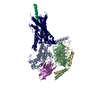


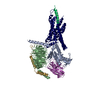
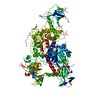


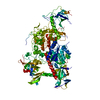
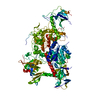
 PDBj
PDBj



















